UK
Supercell thunderstorm hits Lancs after lightning and 'tornado' across north west
Sarah McGee
Thu, 28 December 2023
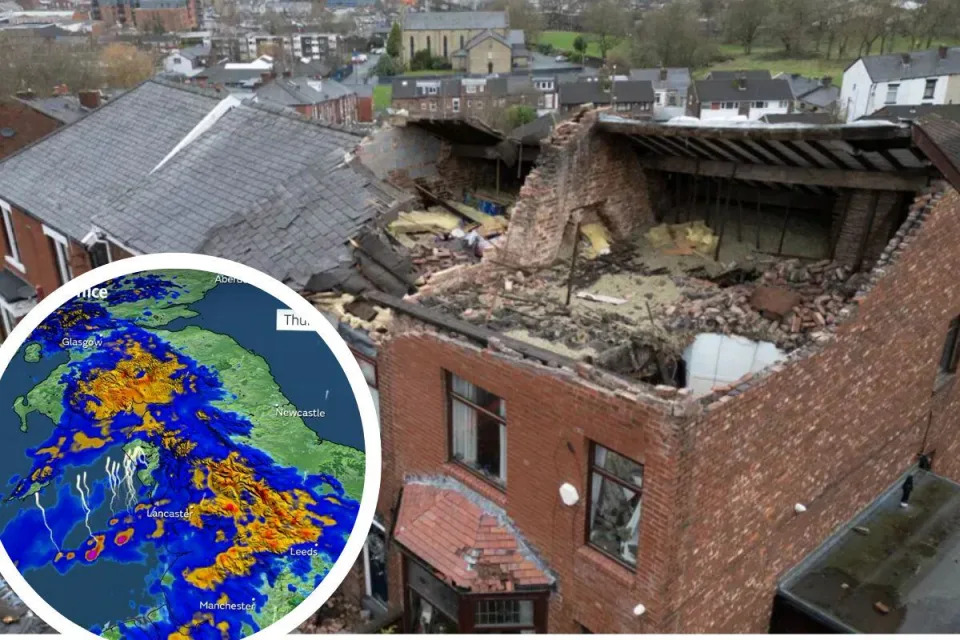
Supercell thunderstorm sweeps across Lancashire, after "localised tornado"
Around 100 properties were damaged by what police called a “localised tornado” in Stalybridge, Tameside, and residents in the badly hit village of Carrbrook told of the states of “absolute disaster” houses were in.
The news of a supercell thunderstorm moving across Lancashire comes as the Met Office reported the “worst” of Storm Gerrit has cleared away as of Thursday afternoon.
The named storm caused power outages and widespread travel disruption.
Meteorologist Alex Burkill said in a Thursday afternoon forecast: “It is still a windy blustery picture for many of us as we go through the rest of today.
“Likely to be some gales, perhaps even severe gales, in some exposed spots and hefty showers; could be some hail, some sleet mixed in with these across parts of Scotland in particular.”
He added that the blustery and showery picture continues overnight and into Friday with winds expected to ease slightly across most of the UK.
A further bout of “very strong winds” and a spell of “intense rain” is expected on Saturday before more unsettled weather with “blustery, showery conditions likely as we go through New Year’s Eve”, the meteorologist said.
“Numerous reports” of damage to property in Stalybridge were made to Greater Manchester Police (GMP) at around 11.45pm on Wednesday, and the force declared a major incident due to the “severity” of the damage caused and the potential risk to public safety.
No injuries were reported but many residents were forced to leave their homes.
Sarah McGee
Thu, 28 December 2023

Supercell thunderstorm sweeps across Lancashire, after "localised tornado"
in Tameside
(Image: PA/Met Office)
A supercell thunderstorm has moved across Lancashire, after the same type of storm is thought to have resulted in a tornado that damaged homes in Greater Manchester.
The thunderstorm is moving east across Morecambe Bay and may bring hail, frequent lightning and gusty winds to parts of Lancashire, according to the Met Office.
Coastal areas of the county appear the be the worst affected by the storm with 48mph winds expected in Morecambe.
Across East Lancashire it is still set to remain wet and windy, with wind speeds expected to reach 41mph.
The Met Office said a supercell thunderstorm crossed Greater Manchester on Wednesday night and that it had a “strong rotating updraft”, which suggests “a tornado at the surface was likely”
A supercell thunderstorm has moved across Lancashire, after the same type of storm is thought to have resulted in a tornado that damaged homes in Greater Manchester.
The thunderstorm is moving east across Morecambe Bay and may bring hail, frequent lightning and gusty winds to parts of Lancashire, according to the Met Office.
Coastal areas of the county appear the be the worst affected by the storm with 48mph winds expected in Morecambe.
Across East Lancashire it is still set to remain wet and windy, with wind speeds expected to reach 41mph.
The Met Office said a supercell thunderstorm crossed Greater Manchester on Wednesday night and that it had a “strong rotating updraft”, which suggests “a tornado at the surface was likely”
The news of a supercell thunderstorm moving across Lancashire comes as the Met Office reported the “worst” of Storm Gerrit has cleared away as of Thursday afternoon.
The named storm caused power outages and widespread travel disruption.
Meteorologist Alex Burkill said in a Thursday afternoon forecast: “It is still a windy blustery picture for many of us as we go through the rest of today.
“Likely to be some gales, perhaps even severe gales, in some exposed spots and hefty showers; could be some hail, some sleet mixed in with these across parts of Scotland in particular.”
He added that the blustery and showery picture continues overnight and into Friday with winds expected to ease slightly across most of the UK.
A further bout of “very strong winds” and a spell of “intense rain” is expected on Saturday before more unsettled weather with “blustery, showery conditions likely as we go through New Year’s Eve”, the meteorologist said.
“Numerous reports” of damage to property in Stalybridge were made to Greater Manchester Police (GMP) at around 11.45pm on Wednesday, and the force declared a major incident due to the “severity” of the damage caused and the potential risk to public safety.
No injuries were reported but many residents were forced to leave their homes.
‘Localised tornado’ damages 100 properties as Storm Gerrit sweeps UK
Ellie Ng, George Lithgow and Rachel Vickers-Price, PA
Thu, 28 December 2023
A “localised tornado” damaged around 100 properties in Greater Manchester as Storm Gerrit swept the country, with thousands of homes remaining without power and travellers likely to face continued disruption.
The storm brought heavy snow across parts of Scotland which, along with high winds and heavy rain, damaged electricity networks in the country as fallen trees, branches and other debris brought down power lines.
It also wreaked havoc on the travel network on Wednesday with a string of train operators – including ScotRail, LNER and Avanti West Coast – suspending and terminating some services, as well as advising customers not to travel.
A “localised tornado” is believed to have caused “significant damage” to homes in Stalybridge, Tameside.
“Numerous reports” were made to Greater Manchester Police (GMP) at around 11.45pm on Wednesday, and the force declared a major incident due to the “severity” of the damage caused and the potential risk to public safety.
No injuries were reported but many residents were forced to leave their homes.
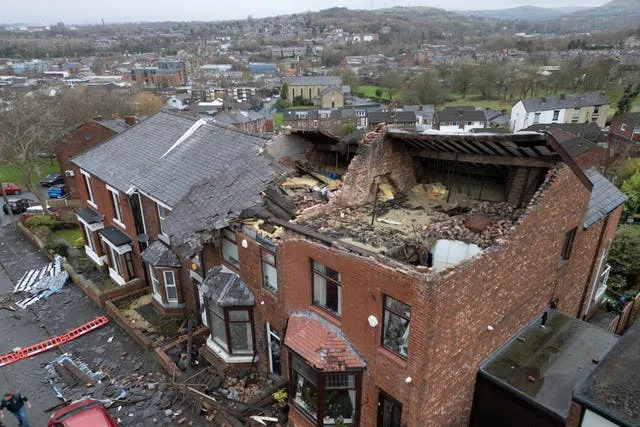
The ‘localised tornado’ ripped off roofs and brought down walls (AP Photo/Jon Super)
Tameside Council said about 100 properties were evacuated after the “mini tornado” hit areas of Carrbrook and Millbrook.
A spokesperson said: “It is believed everyone affected made arrangements to stay with family and friends overnight.
“Our officers have been out all night and continue to be out today clearing debris, fallen trees and making roads, footpaths and other areas safe.”
Chief Superintendent Mark Dexter from GMP said: “This incident has undoubtedly affected numerous people in the Stalybridge area with many residents displaced from their properties during the night.
“Our highest priority is keeping people safe which is why we are advising those who have been displaced not to return or enter their properties which have significant damage until they have been assessed by structural engineers.
“I would also like to urge members of the public to avoid the area where possible and take extra care when travelling in vehicles on the roads in Stalybridge and the surrounding areas, due to debris in the road.”

Roof damage in Stalybridge caused by Storm Gerrit (Richard McCarthy/PA)
Hayley McCaffer, 40, who lives in Carrbrook, told the PA news agency that some of her neighbours’ houses “are an absolute disaster” with missing rooves and “squished” cars.
She and her partner are not sure when they can get back into their home.
Patricia Watkinson, another Carrbrook resident who was away in Norfolk when gusts swept through the village, has been told by a neighbour that apart from a “dangling” aerial her home appears undamaged.
But the 83-year-old told PA that her neighbour’s shed “is gone”.
Authorities in Greater Manchester were also called on Wednesday to weather incidents amid reports of a possible tornado in Dukinfield and Mossley.
Tameside Council opened a reception area at Dukinfield Town Hall to cater for any displaced residents.
The Tornado and Storm Research Organisation said a detailed site investigation would need to be undertaken before it can confirm the damage was caused by a rare British tornado.
Meanwhile, Scottish and Southern Electricity Networks (SSEN) said that as of 11am on Thursday, supplies had been restored to some 34,000 customers, with around 7,700 left without power.
Director of corporate affairs Graeme Keddie told BBC Radio Scotland many of those properties are in north-east Scotland and Shetland.
“One of the main impacts we’ve seen is around access to faults, so blocked roads, flooding in fields, and issues with snow,” he said.
“We’re very hopeful that that will ease today but that has meant our teams on the ground have been saying that (in) the time it would take to fix two or three faults they have only been able to fix one, but we are hopeful of further progress today as weather conditions have eased.”
He added that power may not be restored for some customers until Friday, particularly those who live in heavily affected or rural areas.
Police Scotland confirmed the A9 has fully reopened in both directions and is “passable with care” after snow blocked the road between Drumochter and Dalwhinnie in the Highlands.
Inspector Michelle Burns, from the force’s road policing unit, said: “Conditions for travel in the affected areas may be hazardous and extra caution should be exercised by all road users.”
Scotland’s rail network experienced widespread cancellations and delays with a train driver’s cabin hit by a falling tree. No-one was injured.
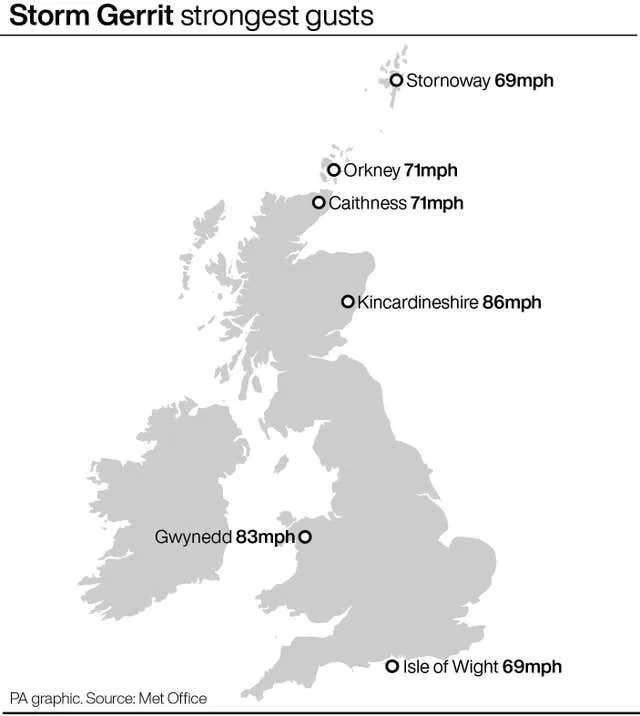
(PA Graphics)
ScotRail has suspended multiple train services until further notice to allow for safety inspections to be carried out.
Avanti West Coast, which operates services on the West Coast Main Line, said on Thursday morning that a tree falling on overhead wires between Rugby and Lichfield Trent Valley means some lines are blocked, extending journey times for services from London Euston towards the North West, as trains are diverted through the Midlands.
Ferry operator DFDS said its sailings between Dover and France are delayed due to strong winds in the Channel.Passengers are being advised to check in as normal and are being put onto the first available sailing.
Heathrow Airport cancelled 18 flights on Wednesday because of air traffic control restrictions including routes from Aberdeen, Edinburgh, Glasgow, Jersey and Manchester as well as to Barcelona, Berlin, Madrid and Paris.
Storm Gerrit also brought plenty of rain, with the Great Langdale Valley in the Lake District recording 80mm – nearly half the usual 178mm monthly rainfall for December, the Met Office said.
The fastest recorded wind gusts were 86mph at Inverbervie in Aberdeenshire, 84mph at Fair Isle in Shetland, and 83mph at Capel Curig, north Wales, the forecaster said.
‘Localised tornado’ rips roofs off houses as Storm Gerrit sweeps across UK
Rebecca Ann Hughes
Thu, 28 December 2023
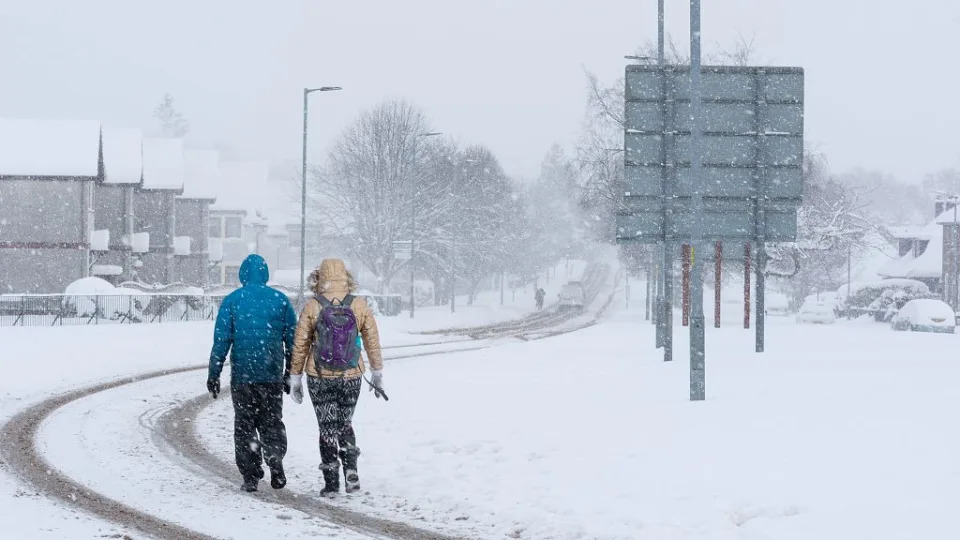
‘Localised tornado’ rips roofs off houses as Storm Gerrit sweeps across UK
A ‘localised tornado’ has severely damaged homes in Greater Manchester as Storm Gerrit batters the UK.
Thousands of people are also without power and travel has been plunged into chaos across the country.
Scotland has experienced heavy snowfall as well as high winds and torrential rain.
Electricity outages have been caused by falling trees and branches bringing down power lines.
Tornado damages houses in the UK
The ‘localised tornado’ is reported to have caused ‘significant damage’ to around 100 properties in Stalybridge in Tameside.
Roofs were ripped off houses, walls collapsed and trees were brought down.
“This incident has undoubtedly affected numerous people in the Stalybridge area with many residents displaced from their properties during the night,” said Chief Superintendent Mark Dexter of the Greater Manchester Police (GMP).
The GMP received ‘numerous reports’ late on Wednesday evening and declared a major incident due to the severity of damage and the possible risk to public safety.
The force said there have been no reports of injuries but many people were forced to flee their homes.
“Our highest priority is keeping people safe which is why we are advising those who have been displaced not to return [to] or enter their properties which have significant damage until they have been assessed by structural engineers,” Dexter added.
“I would also like to urge members of the public to avoid the area where possible and take extra care when travelling in vehicles on the roads in Stalybridge and the surrounding areas, due to debris in the road.”
Scotland loses power as Storm Gerrit hits
Areas of Scotland have been left without power as the storm sweeps the country. Around 16,000 properties are waiting to be reconnected.
Scottish and Southern Electricity Networks (SSEN) have been working to restore connections but say engineers are battling winds of up to 130 km/h in some coastal areas.
‘Unpredictable and dangerous': What is human activity doing to sand and dust storms?
The company has managed to restore power to 25,000 homes so far.
“The widespread extent of the damage, the ongoing adverse weather conditions, and the challenges accessing faults due to fallen trees, flooding and road closures, together mean that full network restoration will take time,” an SSEN spokesman said.
“Some customers in rural areas may be off supply for up to 48 hours.”
Was Storm Gerrit caused by climate change?
The Scottish Green party has said climate change could be the blame for the storm.
"[It is] clear we are suffering ever more severe weather as the climate crisis worsens," the party said.
It added that "we must ensure we can adapt and act accordingly."
Though it’s impossible to pinpoint exactly how much of a role climate change played in generating the tornado, environmental experts have warned that climate change could make storms worse.
Rebecca Ann Hughes
Thu, 28 December 2023

‘Localised tornado’ rips roofs off houses as Storm Gerrit sweeps across UK
A ‘localised tornado’ has severely damaged homes in Greater Manchester as Storm Gerrit batters the UK.
Thousands of people are also without power and travel has been plunged into chaos across the country.
Scotland has experienced heavy snowfall as well as high winds and torrential rain.
Electricity outages have been caused by falling trees and branches bringing down power lines.
Tornado damages houses in the UK
The ‘localised tornado’ is reported to have caused ‘significant damage’ to around 100 properties in Stalybridge in Tameside.
Roofs were ripped off houses, walls collapsed and trees were brought down.
“This incident has undoubtedly affected numerous people in the Stalybridge area with many residents displaced from their properties during the night,” said Chief Superintendent Mark Dexter of the Greater Manchester Police (GMP).
The GMP received ‘numerous reports’ late on Wednesday evening and declared a major incident due to the severity of damage and the possible risk to public safety.
The force said there have been no reports of injuries but many people were forced to flee their homes.
“Our highest priority is keeping people safe which is why we are advising those who have been displaced not to return [to] or enter their properties which have significant damage until they have been assessed by structural engineers,” Dexter added.
“I would also like to urge members of the public to avoid the area where possible and take extra care when travelling in vehicles on the roads in Stalybridge and the surrounding areas, due to debris in the road.”
Scotland loses power as Storm Gerrit hits
Areas of Scotland have been left without power as the storm sweeps the country. Around 16,000 properties are waiting to be reconnected.
Scottish and Southern Electricity Networks (SSEN) have been working to restore connections but say engineers are battling winds of up to 130 km/h in some coastal areas.
‘Unpredictable and dangerous': What is human activity doing to sand and dust storms?
The company has managed to restore power to 25,000 homes so far.
“The widespread extent of the damage, the ongoing adverse weather conditions, and the challenges accessing faults due to fallen trees, flooding and road closures, together mean that full network restoration will take time,” an SSEN spokesman said.
“Some customers in rural areas may be off supply for up to 48 hours.”
Was Storm Gerrit caused by climate change?
The Scottish Green party has said climate change could be the blame for the storm.
"[It is] clear we are suffering ever more severe weather as the climate crisis worsens," the party said.
It added that "we must ensure we can adapt and act accordingly."
Though it’s impossible to pinpoint exactly how much of a role climate change played in generating the tornado, environmental experts have warned that climate change could make storms worse.
What causes a tornado and when was the last one in the UK?
As a 'localised tornado' was believed to have hit Manchester during Storm Gerrit, Yahoo News UK looks at the science behind tornados.
Ellen Manning
Updated Thu, 28 December 2023

Police declared a major incident as roofs were torn off houses and trees uprooted in Stalybridge amid what people think was a tornado. (Getty)
Properties were left damaged and people forced to leave their homes after a "localised tornado" passed over Greater Manchester during Storm Gerrit on Wednesday.
Greater Manchester Police said it received "numerous reports" about the 'tornado' at around 11.45pm in Stalybridge, Tameside on Wednesday, declaring a major incident due to the "severity" of the damage caused and the potential risk to public safety.
No injuries were reported but many residents were forced to leave their homes, with those whose properties had suffered significant damage urged not to return until they had been given the all-clear by structural engineers.
Chief Superintendent Mark Dexter, from Greater Manchester Police (GMP), said: "This incident has undoubtedly affected numerous people in the Stalybridge area with many residents displaced from their properties during the night. Our highest priority is keeping people safe which is why we are advising those who have been displaced not to return or enter their properties which have significant damage until they have been assessed by structural engineers.
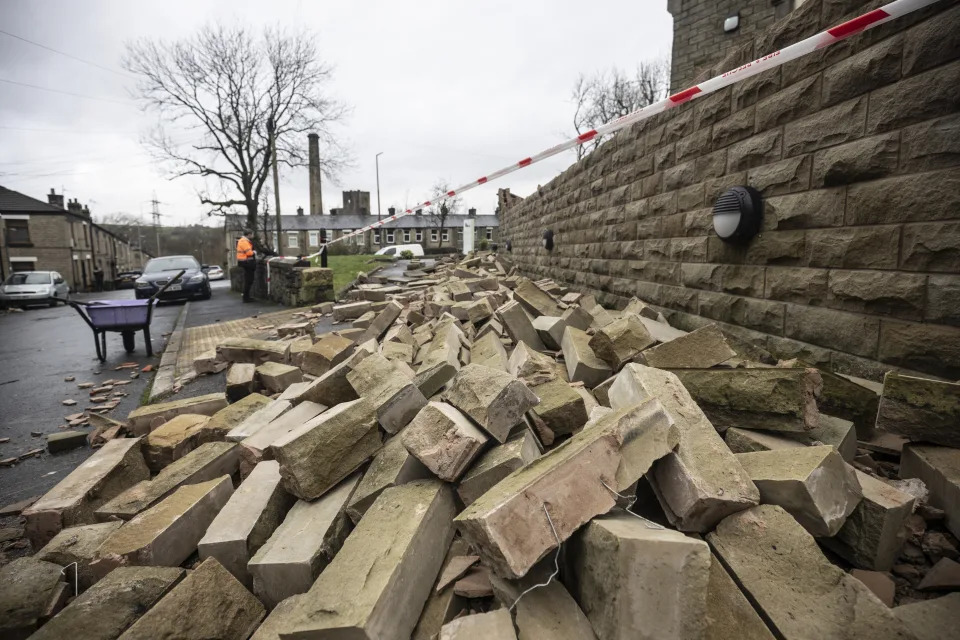
Police declared a major incident as roofs were torn off houses and trees uprooted in Stalybridge amid what people think was a tornado. (Getty)
The Tornado and Storm Research Organisation said a detailed site investigation would need to be undertaken before it can confirm the damage was caused by a tornado.
The Met Office said a supercell thunderstorm – which can cause a tornado – had crossed Greater Manchester on Wednesday night with a "strong rotating updraft". A spokesperson said: "Damage reported from the area would be consistent with a small-scale tornado and radars picked up a feature that could be a tornado. The meteorological conditions in the area also support the possible development of a tornado in the area. Around 30 tornados are reported a year in the UK, though they often occur where there are little to no impacts or are very short-lived features."
Recommended reading
Tornadoes in the UK are surprisingly common and no one knows why (The Conversation)
Rare tornado-like phenomenon spotted over Suffolk (East Anglian Daily Times)
UK weather: Tornado damages homes and cars in Surrey (Sky News)
What is a tornado and what causes one?
Tornadoes are vertical funnels of rapidly spinning air. They often come from supercells - large thunderstorms with winds that are already in rotation. According to National Geographic, around one in a thousand storms becomes a supercell, and one in five or six supercells spawns off a tornado.
A tornado forms when warm, humid air collides with cold, dry air. The denser cold air is pushed over the warm air, usually producing thunderstorms. The warm air rises through the colder air, causing an updraft.
If winds vary sharply in speed or direction, that updraft starts to rotate, called a mesocycle. As that mesocycle draws in more warm air from the moving thunderstorm, its rotation speed increases and water droplets from its moist air form a funnel cloud which continues to grow and eventually drops down from the cloud to touch the ground - at which point it becomes classified as a tornado.
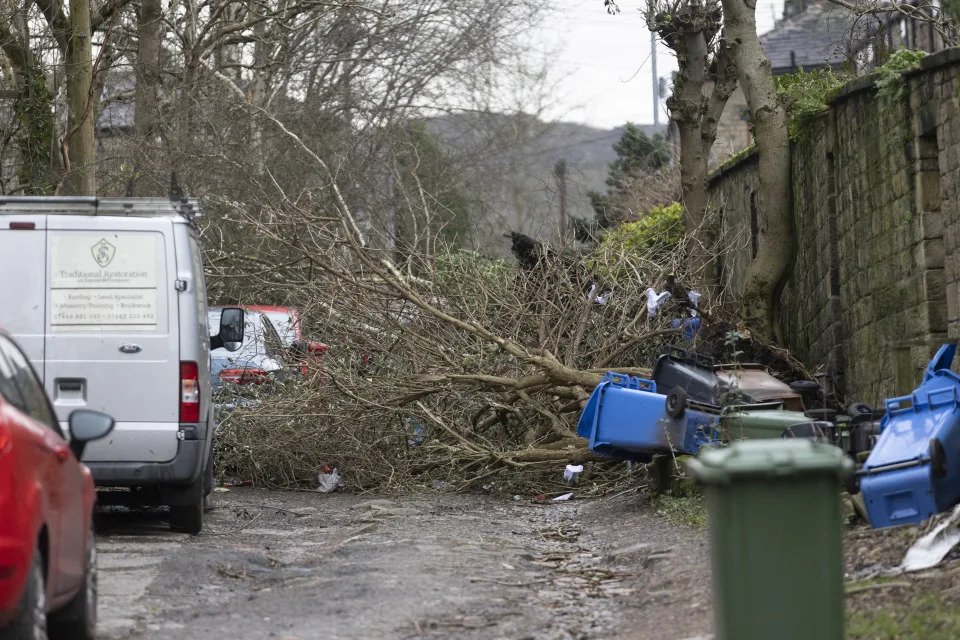
People were forced to leave their homes amid the "localised tornado". (Getty)
The tornado then moves across the surface causing severe damage or destruction to objects in its path. Tornado size and intensity vary greatly, the Met Office says, with a typical tornado 20-100m wide at the surface, lastings for a few minutes and with a track of around a mile (1.6km). Tornado damage is localised; limited by the track of the tornado.
Around 30 tornadoes a year are reported in the UK, according to the Met Office, which are typically small and short-lived, but can cause structural damage if they pass over built-up areas.
When was the last tornado in the UK?
Tornadoes are tracked by the Tornado and Storm Research Organisation (TORRO), which categorises them using a scale measuring their intensity based on wind speed, track length, track width and track area.
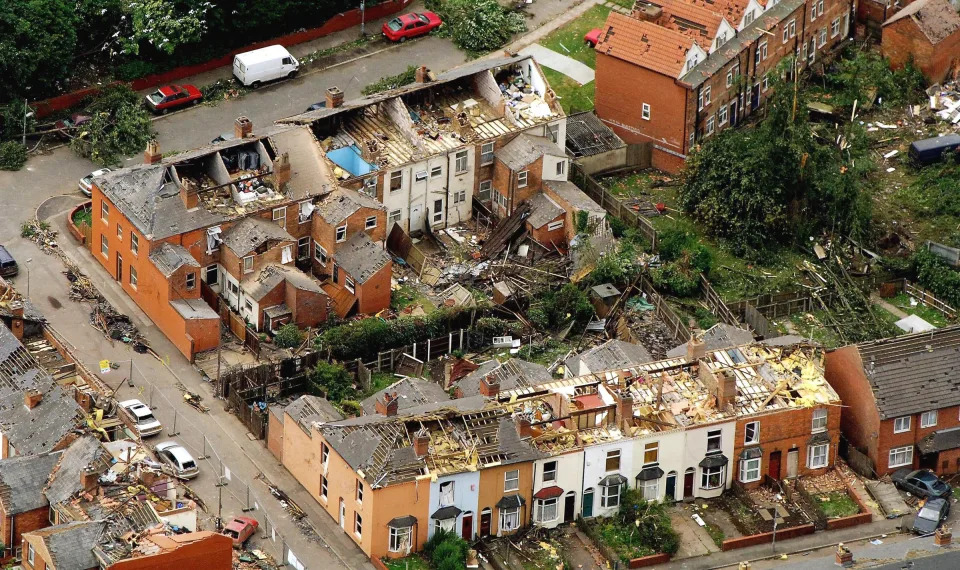
The scene from the air of Alder Street, Sparkbrook, Birmingham, after a tornado in 2005. (Getty)
The most recent tornado in the UK was in Birmingham in July 2005, measuring T6 on the TORRO scale, causing £40m of damage - reportedly the costliest tornado if not the strongest. A tornado that hit Gunnersbury in London in 1954 was stronger, measuring T7 on the scale.
Accoridng to TORRO, the most intense tornado on record for the UK was in 1666 when a tornado passed through Lincolnshire, measuring T8-9 with a reported maximum track width of 200m and a track length of 5km.
As a 'localised tornado' was believed to have hit Manchester during Storm Gerrit, Yahoo News UK looks at the science behind tornados.
Ellen Manning
Updated Thu, 28 December 2023
Police declared a major incident as roofs were torn off houses and trees uprooted in Stalybridge amid what people think was a tornado. (Getty)
Properties were left damaged and people forced to leave their homes after a "localised tornado" passed over Greater Manchester during Storm Gerrit on Wednesday.
Greater Manchester Police said it received "numerous reports" about the 'tornado' at around 11.45pm in Stalybridge, Tameside on Wednesday, declaring a major incident due to the "severity" of the damage caused and the potential risk to public safety.
No injuries were reported but many residents were forced to leave their homes, with those whose properties had suffered significant damage urged not to return until they had been given the all-clear by structural engineers.
Chief Superintendent Mark Dexter, from Greater Manchester Police (GMP), said: "This incident has undoubtedly affected numerous people in the Stalybridge area with many residents displaced from their properties during the night. Our highest priority is keeping people safe which is why we are advising those who have been displaced not to return or enter their properties which have significant damage until they have been assessed by structural engineers.
Police declared a major incident as roofs were torn off houses and trees uprooted in Stalybridge amid what people think was a tornado. (Getty)
The Tornado and Storm Research Organisation said a detailed site investigation would need to be undertaken before it can confirm the damage was caused by a tornado.
The Met Office said a supercell thunderstorm – which can cause a tornado – had crossed Greater Manchester on Wednesday night with a "strong rotating updraft". A spokesperson said: "Damage reported from the area would be consistent with a small-scale tornado and radars picked up a feature that could be a tornado. The meteorological conditions in the area also support the possible development of a tornado in the area. Around 30 tornados are reported a year in the UK, though they often occur where there are little to no impacts or are very short-lived features."
Recommended reading
Tornadoes in the UK are surprisingly common and no one knows why (The Conversation)
Rare tornado-like phenomenon spotted over Suffolk (East Anglian Daily Times)
UK weather: Tornado damages homes and cars in Surrey (Sky News)
What is a tornado and what causes one?
Tornadoes are vertical funnels of rapidly spinning air. They often come from supercells - large thunderstorms with winds that are already in rotation. According to National Geographic, around one in a thousand storms becomes a supercell, and one in five or six supercells spawns off a tornado.
A tornado forms when warm, humid air collides with cold, dry air. The denser cold air is pushed over the warm air, usually producing thunderstorms. The warm air rises through the colder air, causing an updraft.
If winds vary sharply in speed or direction, that updraft starts to rotate, called a mesocycle. As that mesocycle draws in more warm air from the moving thunderstorm, its rotation speed increases and water droplets from its moist air form a funnel cloud which continues to grow and eventually drops down from the cloud to touch the ground - at which point it becomes classified as a tornado.
People were forced to leave their homes amid the "localised tornado". (Getty)
The tornado then moves across the surface causing severe damage or destruction to objects in its path. Tornado size and intensity vary greatly, the Met Office says, with a typical tornado 20-100m wide at the surface, lastings for a few minutes and with a track of around a mile (1.6km). Tornado damage is localised; limited by the track of the tornado.
Around 30 tornadoes a year are reported in the UK, according to the Met Office, which are typically small and short-lived, but can cause structural damage if they pass over built-up areas.
When was the last tornado in the UK?
Tornadoes are tracked by the Tornado and Storm Research Organisation (TORRO), which categorises them using a scale measuring their intensity based on wind speed, track length, track width and track area.
The scene from the air of Alder Street, Sparkbrook, Birmingham, after a tornado in 2005. (Getty)
The most recent tornado in the UK was in Birmingham in July 2005, measuring T6 on the TORRO scale, causing £40m of damage - reportedly the costliest tornado if not the strongest. A tornado that hit Gunnersbury in London in 1954 was stronger, measuring T7 on the scale.
Accoridng to TORRO, the most intense tornado on record for the UK was in 1666 when a tornado passed through Lincolnshire, measuring T8-9 with a reported maximum track width of 200m and a track length of 5km.


No comments:
Post a Comment